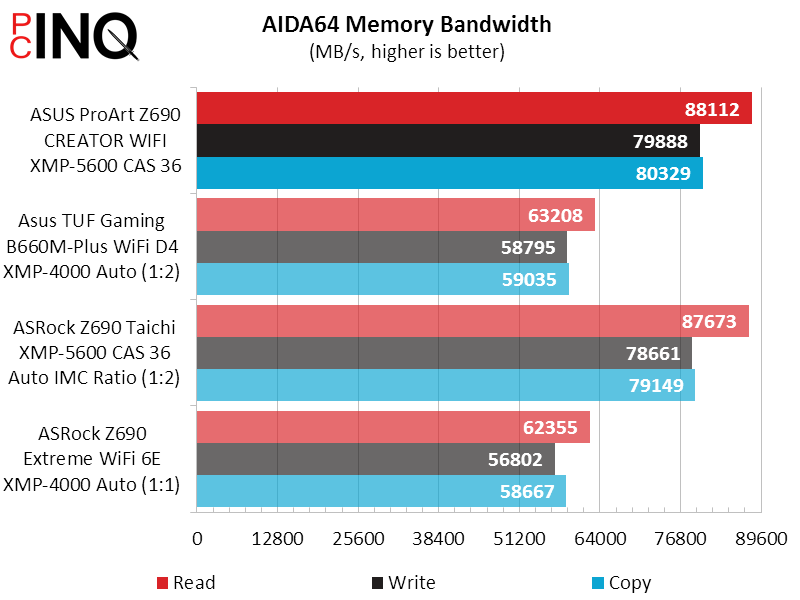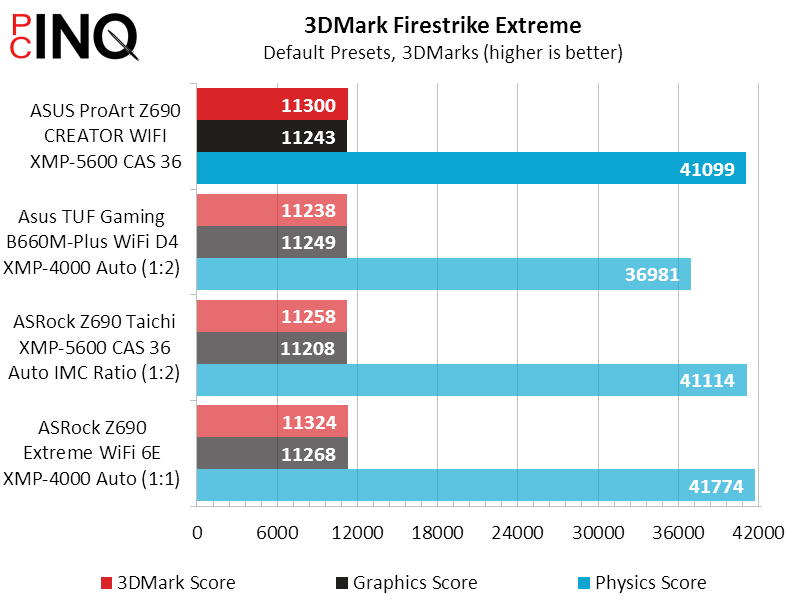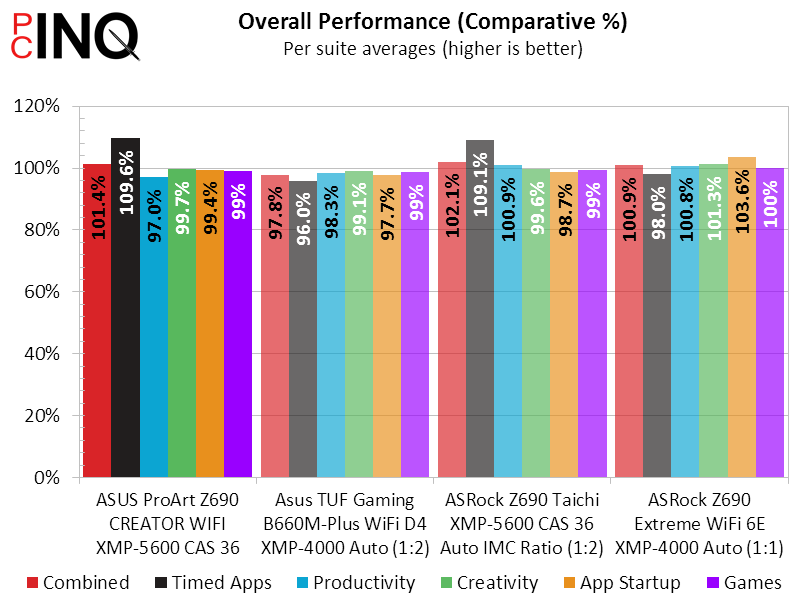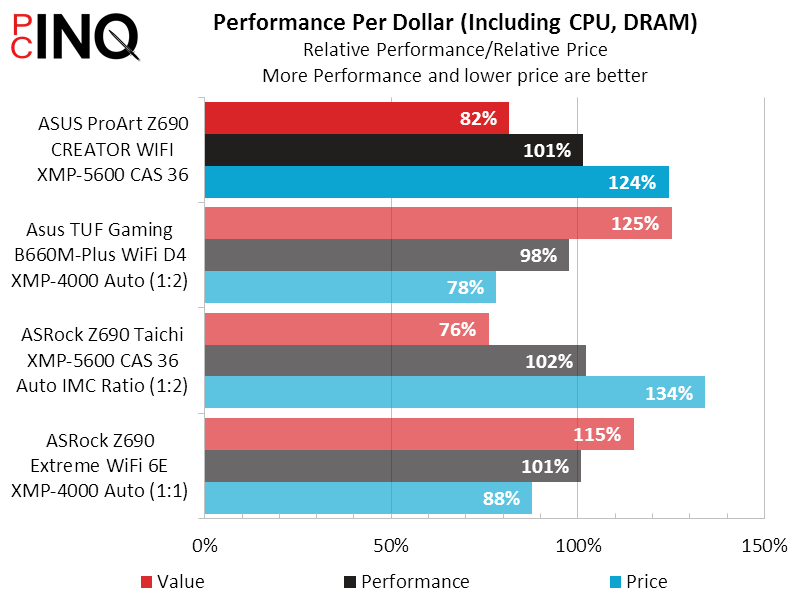Asus ProArt Z690 Creator WiFi Review: High-End Value Contender?
Benchmark Results & Final Analysis
Contents
| Benchmark Settings | |
| Synthetic Benchmarks and Settings | |
| PCMark 10 | Essentials, Productivity, Digital Content Creation |
| 3DMark Professional Edition | Timespy, Firestrike Extreme Default Presets |
| SiSoftware Sandra | Version 2021.11.31.53 Memory Bandwidth, Memory Latency |
| Cinebench R23.2 | Build RBENCHMARK330542 CPU Multi Core Benchmark |
| AIDA64 | Version 6.50.5800, BenchDLL v4.5.859.8-x64 |
| Application Tests and Settings | |
| LAME MP3 | Version 3.98.3 Mixed 271MB WAV to mp3: Command: -b 160 –nores (160 Kb/s) |
| HandBrake CLI | Version: 0.10.5-x86_64 Sintel Open Movie Project: 4.19 GB 4k mkv to x265 mp4 |
| Blender | Version 2.93.5 BMW 27 CPU Render Benchmark, BMW 27 GPU Render Benchmark |
| 7-Zip | Version 21.04 Beta integrated benchmark + custom workload bench: 7.6 GB mixed files to .7z, CL switches “a -t7z -r -m0=LZMA2 -mx=9” |
| Prime95 | Version 30.7 Torture Test, Small FFTs |
| Games | |
| F1 2021 | 1920×1080, Ultra High quality preset, TAA, 16X AF, Bahrain (dry) |
Today’s benchmark results focus entirely on automatic settings, which is usual: Extended data from a previous test that included manual “Gear 1” memory controller mode for the Tuf Gaming B660M-Plus WiFi D4 is available within that product’s review.




The Taichi edges out the ProArt Z690 Creator WiFi in both bandwidth and latency, though the Z690 DDR4 board had the best latency overall. The B660 model suffers from its 1:2 memory controller ratio, which it automatically applied to DDR4-4000.





The ProArt Z690 Creator WiFi wins 3DMark Time Spy’s CPU score by a trivial amount, while its gaming competitor edges it out by a similar margin in Firestrike Extreme Physics. PCMark’s App Startup appears to prefer DDR4-4000 at a 1:1 memory controller ratio, and its productivity tests appear to prefer either ASRock board to either Asus model, even after we tried retesting it.




With something other than memory performance holding back F1 2021, we had to scroll through to 7.Zip tests to find any significant performance difference between various board models. The Taichi leads 7.Zip’s synthetic test, but the ProArt Z690 Creator WiFi overtakes it when compressing our actual test file.


Both Asus motherboards draw significantly more power under load than their ASRock counterparts, yet both Asus models also idle down better. The added power draw is reflected in CPU and voltage regulator temperature. Given its lack of a voltage regulator cooling fan, it appears that Asus probably made a thermally efficient choice in its ProArt Z690 Creator WiFi’s MOSFETs.


The ProArt Z690 Creator WiFi’s anomalous results in Futuremark Productivity are somewhat bothersome since those tests use real-world applications, yet it gains enough in other benchmarks to come up less than 1% short of the Tachi’s benchmarking high. Content Creation was among the Creator’s smaller leads, which is handy given its branding.


Thanks to a price that’s at least $100 lower than the Taichi, the ProArt Z690 Creator WiFi beats its DDR5 gaming rival in performance per dollar. Things get even tougher for the gaming board when we begin to consider how much more the ProArt Z690 Creator WiFi 10GbE network interface is worth than the Taichi’s combination of bigger voltage regulator, black-anodized aluminum backplate, onboard buttons and RGB lighting. Power Users are among those most likely to notice that none of the Taichi’s added features increase their system’s usefulness, while the ProArt Z690 Creator WiFi’s 10GbE just might. Asus proves that it knows power users with razor-sharp focus on things that this target market actually cares about.
| Asus ProArt Z690 Creator WiFi | |
| Pros | Cons |
|
|
| The Verdict | |
| With faster networking, more high-speed M.2 storage, a cleaner look and a lower price, Asus builds its ProArt Z690 Creator WiFi for Power Users…to the exclusion of show-system builders. | |
With its superior interface set and lower price, the ProArt Z690 Creator WiFi earns our highest recommendation for Power Users.


